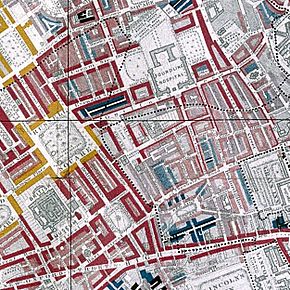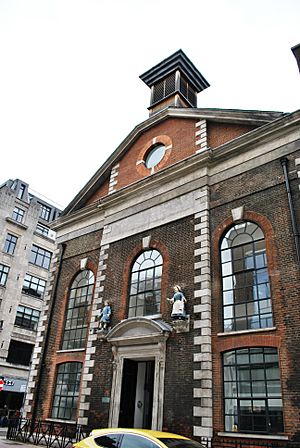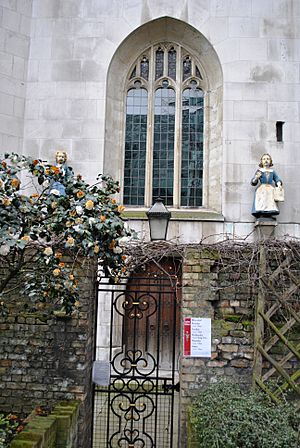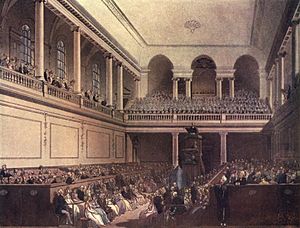Foundling Hospital facts for kids

1753 engraving of the Foundling Hospital building, now demolished
|
|

1889 map of Bloomsbury, showing the Foundling Hospital
|
|
| Successor | Thomas Coram Foundation for Children; Ashlyns School |
|---|---|
| Formation | 25 March 1741 |
| Founder | Thomas Coram |
| Founded at | London, Great Britain |
| Dissolved | 1951 |
| Type | Orphanage |
| Legal status | Closed |
| Purpose | "The education and maintenance of exposed and deserted young children" |
| Location |
|
|
Founding Governor
|
William Hogarth |
|
Governor
|
George Frederic Handel |
The Foundling Hospital was a special home for children in London, England. It was started in 1739 by a kind sea captain named Thomas Coram. His goal was to provide a safe place for "exposed and deserted young children."
Back then, the word "hospital" meant a place that offered "hospitality" or care to those in need. The Foundling Hospital focused on keeping children healthy. They worked hard to prevent illnesses like smallpox and fevers. They also made sure the environment was clean and provided simple clothes and food.
Contents
Early Days of the Hospital
How the Hospital Started


Thomas Coram worked for many years to get the hospital started. In 1735, he asked King George II to approve his idea. Important women from noble families signed his first request. This made his project very popular.
More requests were signed by noblemen and important people in 1737. Finally, in 1739, King George II signed the official document. This document listed the hospital's goals and rules. It also named many important people as founding governors. These included dukes, earls, and the Lord Mayor of London.
Admitting Children
The first children arrived at the Foundling Hospital on March 25, 1741. They stayed in a temporary house in Hatton Garden. At first, no questions were asked about the children or their parents. Instead, a special item was recorded. This could be a coin, a trinket, or a piece of fabric. These items could help identify a child later if a parent returned.
By 1758, the hospital started giving receipts to parents. This made the special tokens less necessary. However, many parents still left tokens. Records show that between 1750 and 1755, over 2,500 children were brought to the hospital. But only about 780 could be taken in. There wasn't enough money to help everyone.
From 1756 to 1760, the government provided financial help. During this time, the hospital accepted all children. Admission rates jumped to 4,000 children per year. After 1763, parents had to apply and share their names and situations. Children were usually not accepted if they were older than 12 months.
When children were first admitted, they were sent to wet nurses in the countryside. They stayed there until they were about four or five years old. Local clergy or important people often checked on the children.
When they were older, girls usually became apprenticed as servants at age 16. Boys were apprenticed into different jobs at age 14. They usually worked for seven years.
The New Building
In September 1742, construction began on a new hospital building. It was built in Bloomsbury, an area north of Great Ormond Street. The hospital was designed by Theodore Jacobsen. It was a simple brick building with two wings and a chapel. The western wing was finished in 1745. An eastern wing was added in 1752 to keep girls and boys separate.
In 1756, the House of Commons decided that all children offered should be accepted. They also said that receiving places should be set up across the country. A basket was hung outside the hospital for children to be left. The age limit for admission was raised to 12 months.
Many children arrived from country workhouses. In less than four years, nearly 15,000 children were brought to the hospital. Sadly, only about 4,400 of these children survived to be apprenticed. The cost was very high, which worried the House of Commons.
The hospital then had to rely on its own money again. They started asking for large sums of money to admit children. This sometimes led to parents reclaiming their children. This practice stopped in 1801. After that, no money was accepted for admission. The hospital committee had to be sure the mother was of good character and truly needed help. They also needed to know the father had left the family. The goal was to help the mother return to an honest life.
Art and Music at the Hospital
The Foundling Hospital became a very popular charity. Many famous artists and people in high society supported it. One important supporter was the painter William Hogarth. He was a founding governor of the hospital.
Art Collection
Hogarth helped design the children's uniforms and the hospital's coat of arms. He and his wife even fostered some foundling children. Hogarth also decided to create a permanent art exhibition at the hospital. He encouraged other artists to donate their work.
By having a public art display, Hogarth made the hospital a fashionable place to visit. People came to see the art and donate money. At that time, there were no public art galleries in Britain. So, Hogarth's idea helped create Britain's first public art space.
Many famous English artists donated their paintings. These included Sir Joshua Reynolds, Thomas Gainsborough, and Richard Wilson. Hogarth himself painted a portrait of Thomas Coram for the hospital. He also gave his painting Moses Brought Before Pharaoh's Daughter. The hospital also owned a sculpture of Handel by Roubiliac.
The art exhibitions at the Foundling Hospital led to the creation of the Royal Academy in 1768. Today, you can see the Foundling Hospital's art collection at the Foundling Museum.
Musical Contributions

In May 1749, the famous composer George Frederic Handel held a special concert in the hospital chapel. He performed his new choral piece, the Foundling Hospital Anthem. This work included the "Hallelujah" chorus from his famous oratorio, Messiah.
On May 1, 1750, Handel led a performance of Messiah to celebrate the gift of an organ to the chapel. This concert was a huge success. The next day, Handel was elected a Governor of the hospital. He continued to perform Messiah there every year. This helped make the piece very popular in Britain. Handel also left a copy of the full musical score to the hospital.
The hospital's musical services became very well-known thanks to Handel. In 1847, a successful children's band was started. Music was found to be very good for the children's education. The hospital even provided many musicians for army and navy bands.
Moving to a New Home
In the 1920s, the hospital decided to move to a healthier location outside the city. The original building was sold in 1926 and later torn down.
The children first moved to Redhill, Surrey. Then, in 1935, they moved to a new building in Berkhamsted, Hertfordshire. In the 1950s, British law changed. It focused more on placing children in families through adoption or foster care. Because of this, the Foundling Hospital stopped most of its operations.
The Berkhamsted buildings were sold to be used as a school (Ashlyns School). The Foundling Hospital changed its name to the Thomas Coram Foundation for Children. Today, it is known as Coram.
The Foundling Hospital Today
The Foundling Hospital still has a presence at its original London site. Seven acres of the land were bought to be a playground for children. This was made possible with help from Lord Rothermere. This area is now called Coram's Fields. It is run by a charity called Coram's Fields and the Harmsworth Memorial Playground.
The original Foundling Hospital charity bought back some land in 1937. They built a new headquarters and a children's center there. This new building looks similar to the old hospital. It now houses the Foundling Museum. This museum is a separate charity where you can see the hospital's art collection.
The original charity still exists as Coram. It is officially called the Thomas Coram Foundation for Children. The hospital's old records, from 1739 to 1954, are kept safe. Many of these records have been put online for people to see.
In Books and Stories
The Foundling Hospital has inspired characters and settings in many books.
The famous author Charles Dickens lived near the Foundling Hospital in the 1840s. He wrote about foundlings in his novels. For example, Tattycoram in Little Dorrit and Walter Wilding in No Thoroughfare are foundlings. In a short story, Dickens wrote about two foundlings, numbers 20,563 and 20,564.
The Foundling Hospital is also the setting for Jamila Gavin's 2000 novel Coram Boy. This story shows some of the challenges of the time. It includes people who took advantage of families trying to get their children to the hospital.
The hospital appears in three books by Jacqueline Wilson: Hetty Feather, Sapphire Battersea, and Emerald Star. In Hetty Feather, the main character arrives at the hospital after living with a foster family. The book describes her new life there.
In 2020, Stacey Halls published The Foundling (or The Lost Orphan in the U.S.). This book tells the story of Bess Bright, who leaves her daughter Clara at London's Foundling Hospital. The book became a Sunday Times Best Seller.
See also
- Child abandonment
- List of demolished buildings and structures in London
- Thomas Coram Foundation for Children




